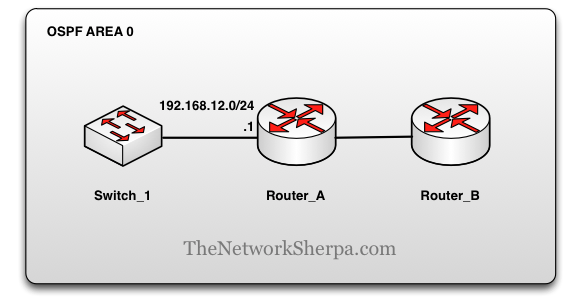OSPF – BROADCAST interfaces and Type-2 LSAs
A test – What LSAs will broadcast interfaces generate?

You have just added a new workgroup switch, switch_1 to your network. You have the following conditions.
- Router_A and Router_B were already fully adjacent over an OSPF point-to-point link.
- Network 192.168.12.0/24 is immediately advertised by Router_A to Router_B.
- There are no other OSPF routers connected to Switch_1.
- Router_A interface Gi1/0 is up/up, has OSPF network-type BCAST and has assumed the role of DR for that segment.
My question to you is, “What LSA(s) will Router_A send to Router_B to describe this new OSPF link?”. Your choices are:
- Add a ‘Stub’ type-3 link to Router LSA
- Add a ‘Transit’ type-2 link to Router LSA
- A new network-LSA
- BOTH a new Network-LSA, AND add a ‘Transit’ type-2 link to Router LSA
[Don’t scroll any further until you have an answer in your head – or skip straight ahead if this sort of shit annoys you]
The Solution
It’s entirely understandable if you chose option 4, but it’s not correct. Option 4 would be correct if R1 had become adjacent with another router on it’s Gi1/0 interface. The Network LSA is not needed here, as it’s only useful if there are adjacencies on that shared segment.
The correct option is option 1. Even though Gi1/0 has a DR state, the Switch_1 link is still described by a Router LSA stub-link. I had first assumed that having DR state meant that you generated a transit link and a network LSA, but it’s not that simple. The DR state means that if a new OSPF router appears on that segment, then R1 would generate the Network LSA and modify it’s Router LSA link from ‘stub’ to ‘transit’.
Check the RFC
Okay so you don’t have to check the RFC; I’ve done that bit for you. Here’s the decision logic for the Router LSA changes, excerpted from section 12.4.1.2 of RFC 2328.
…If the state of the interface is Waiting, add a Type
3 link (stub network)…
…If the router is fully adjacent to the Designated Router, or if the router itself is Designated Router and is fully adjacent to at least one other router, add a single Type 2 link(transit network)
…Otherwise, add a link as if the interface state were Waiting
Okay that’s interesting, And heres the description of the Network LSA behavior, quoted from section 12.4.2 of RFC 2328.
The Designated Router for the network originates the LSA. The Designated Router originates the LSA only if it is fully adjacent to at least one other router on the network.
Can I have a diagram please?
I’ve combined the rules from the RFC to make a flowchart. The focus is solely on BCAST interfaces though, so don’t shoot me if it doesn’t include everything you need.
Sherpa Summary
I wrote this post because I had misunderstood the behavior of OSPF BCAST interfaces. I was asking an advanced interview candidate about this, but didn’t have the behavior absolutely correct. If you’ve been looking for clarification, then I hope this post helps.
As always please keep me honest, and let me know if you see any mistakes. Also feel free to let me know if you need any clarification.

6 thoughts on “OSPF – BROADCAST interfaces and Type-2 LSAs”
I just wanted to let you know I enjoyed your last few blogs. They have been very informative and quite unique. Keep them coming!
Thanks Adam, really appreciate the feedback. You have some pretty good stuff at packetsdropped.wordpress.com too.
I love to ask candidates why the network lsa exists. I find it so elegant that the protocol designers created a simple way to represent a shared network as a single node in the shortest path tree.
Too true Peter. I should do a blog post on the type-2 alone. This site gets a lot of queries on ‘why do we need a type-2 LSA’.
Very nice and detailed explanation to clear the smoke for apprentices like me sir. Many thanks.
Glad I could help.